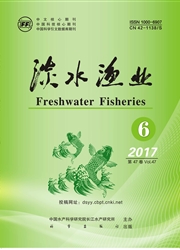

 中文摘要:
中文摘要:
基于2014年7月于黄山殷溪河采集的94尾光唇鱼(Acrossocheilus fasciatus)标本,初步研究了该物种的食性特点,分析了其食物组成及其多样性随年龄和全长增长的变化。渔获物的个体全长为17.93~357.72 mm,分为5个年龄组。光唇鱼的食物由陆生和水生植物、陆生昆虫、碎屑以及环节动物、软体动物、甲壳动物、水生昆虫等水生动物组成,其中以水生昆虫、水生植物和碎屑为常见和优势饵料种类。单因素相似性分析结果显示,1~3龄组间的食物类型数无显著差异,但食物多样性指数和宽度指数均存在显著差异。Pearson's相关分析结果显示,随个体全长增大,食物类型数显著增多而宽度指数显著下降,但食物多样性无显著变化。此外,冗余分析结果显示,光唇鱼的食物组成与个体全长显著相关;随个体全长增大,胃含物中水生昆虫类逐渐减少而甲壳类和陆生昆虫逐渐增多,但水生植物和碎屑的多度与全长无明显关系。
 英文摘要:
英文摘要:
Based on the specimens of Acrossocheilus fasciatus collected from the Yinxi stream of the Huangshan mountain during July 2014,the feeding habits of this species and the pattern of how diet composition and diversity relate to ages and total-lengths were examined in this study. A total of 94 specimens were collected,ranging from 17. 93 mm to 357. 72 mm in total length and comprising five age groups. The diet of A. fasciatus were mainly composed of eight diet-categories,including terrestrial plant,aquatic plant,terrestrial insect,detritus,aquatic annelid,mollusk,crustacean and aquatic insect,among which the most common and dominant diet-categories involved aquatic plant,aquatic insect and detritus. According to the results of One-way ANOVA,H-and B-indices differed significantly across 1 ~ 3 age groups,but the number of diet-categories did not show this significant among-age variation. The results of Pearson' s correlation analysis showed that total length significantly related positively to number of diet-categories but negatively to B-index; however,no significant correlation was observed between total length and H-index. In addition,based on the RDA results,diet composition had significant correlation with total length. Aquatic insects increased but crustacean and terrestrial insect decreased with total length increasing. However,aquatic plant and detritus showed no obvious relation to total length.
 同期刊论文项目
同期刊论文项目
 同项目期刊论文
同项目期刊论文
 期刊信息
期刊信息
